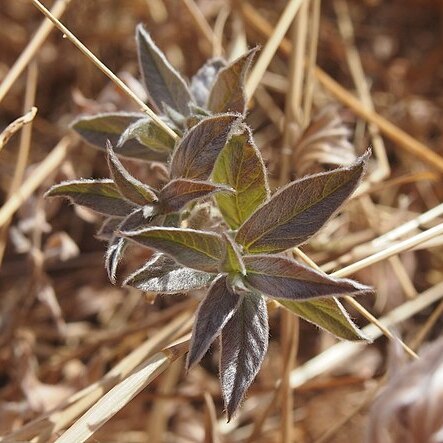Herbs annual. Stems erect to decumbent, simple or branched basally, 8-60 cm; branchlets densely pilose, ± glabrescent. Petiole 0.5-7 mm, sparsely pilose; leaf blade entire, coarsely dentate, or irregularly pinnatifid with few segments, usually 3-cleft; middle segment linear-lanceolate, 2-2.5 cm X 2-3 mm; lateral segments broadly linear, 4-8 X 1-2 mm, sparsely pilose and ciliate, base cuneate and attenuate. Flowers solitary, axillary; bracts linear, 1-2 cm, villous. Peduncles and pedicels very short or absent. Sepals with a distinct midvein, 8-10 mm, pubescent, apex long acuminate; outer ovate-lanceolate, entire or with 1 or 2 teeth at margin; inner ones lanceolate. Corolla red-purple or rarely white, tubular-funnelform, ca. 1.3 cm, glabrous. Stamens included. Ovary and style glabrous. Capsule enclosed in calyx, globose, ca. 5 mm, 2-loculed, 4-valved. Seeds ca. 3 mm, gray-brown tomentellous.
Annual or biennial; stems erect or prostrate, to 0.6 m., usually shorter, hairy.. Leaf-blade ovate, oblong or elliptic, subentire or coarsely, shallowly to deeply lobed, 2–4(–5) cm. long, 1–2(–4) cm. wide, pubescent; petiole up to l.5(–2.7) cm. long.. Flowers axillary, solitary; pedicels 2–3 mm. long; bracts linear, up to 7 mm.. Outer sepals pilose, with ovate-orbicular basal part which is subhyaline and coriaceous with prominent foliaceous midrib and margins and a narrow attenuate acute foliaceous apical part; basal part 6 × 4 mm. and apical part 5 × 1–1.5 mm.; inner sepals narrower.. Corolla white or pink often with a darker centre, narrowly funnel-shaped, 1.4–1.6 cm. long.. Capsule globose, glabrous, straw-coloured, 6.5 mm. in diameter.. Seeds densely adpressed pubescent.
A small shrub. It can re-grow each year or last for a couple of years. This plant varies considerably. The stems can stick up or hang over. They do not twine. Stems are reddish. They come from a fleshy rootstock. The young growth is covered with fine white hairs. The leaves are 2-6 cm across and 0.5-2 cm wide. The leaves are oblong. The lower leaves have lobes or coarse teeth. The flowers are trumpet shaped and 1-1.5 cm across. They are pink or purple with a dark throat. The flowers occur singly in the axils of the upper leaves. Flowers only have very short flower stalks. The seed capsule is 0.5 cm across. The seeds have short hairs. There are 4 seeds in a capsule.
Leaf lamina ovate, oblong or elliptic, 2–4 × 1–1·6 cm., base acute, attenuate into the petiole, apex acute or obtuse to rounded, mucronulate, margin subentire, undulate or coarsely dentate, shallowly to deeply lobed, sometimes irregularly pinnatifid with few segments, or lyrate with a large, ovate or elliptic entire to coarsely dentate terminal segment and small triangular to hastate basal ones, pubescent; petiole up to 2 cm. long, sparsely pilose.
Sepals unequal, the outer three more or less 11 mm. long, pilose, with the ovate-circular basal part subhyaline and coriaceous, with prominent foliaceous midrib and margins and a narrow attenuate acute apical part, the inner sepals narrower.
Stems erect or prostrate, simple or branched from the base; young parts densely pilose, adult parts less densely so to glabrous.
Flowers axillary, solitary; peduncle and pedicel very short or absent; bracts linear, up to 7 mm. long, hairy.
Corolla narrowly funnel-shaped, white or pink often with a darker centre, 1·4–1·6 cm. long.
Capsule globose, glabrous, straw-coloured.
Seeds densely appressed pubescent.
Annual or biennial.
Ovary glabrous.

